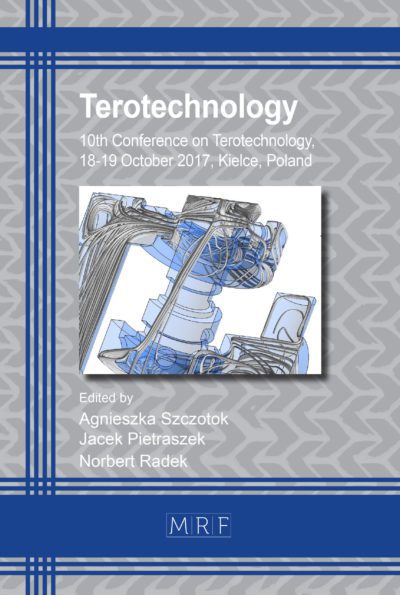Investigating the effect of the addition of WC into NiTi for stent application
AGARWAL Neha, PERUMAL Gopinath, OBEIDI Muhannad Ahmed, BRABAZON Dermot
download PDFAbstract. Nitinol is used for self-expandable stents used in biomedical applications considering their excellent properties of being superelastic and biocompatible. Minimally invasive implants need to be securely positioned in the human body with the property of being visible with the help of X-rays. Limited radiopacity of nitinol implants requires additional markers on the implants to facilitate accurate placement of the implant. This study explores the path of adding different concentrations of tungsten carbide (WC) to nickel-rich nitinol powder. Tests were conducted by compacting the mixed powders with a hydraulic press and then furnace sintering the green samples, with varying pressures and temperatures, to produce the solid parts. The mechanical properties of density and hardness of the sintered samples were measured and compared. An increase in hardness from 76 HV to 150 HV indicated that better mechanical properties could be achieved. Fully dense samples without any pores were obtained. These results show potential for the introduction of WC to nitinol for additively manufactured parts.
Keywords
Powder Alloying, Radiopacity, Compaction, Sintering, Hardness
Published online 4/24/2024, 8 pages
Copyright © 2024 by the author(s)
Published under license by Materials Research Forum LLC., Millersville PA, USA
Citation: AGARWAL Neha, PERUMAL Gopinath, OBEIDI Muhannad Ahmed, BRABAZON Dermot, Investigating the effect of the addition of WC into NiTi for stent application, Materials Research Proceedings, Vol. 41, pp 249-256, 2024
DOI: https://doi.org/10.21741/9781644903131-28
The article was published as article 28 of the book Material Forming
![]() Content from this work may be used under the terms of the Creative Commons Attribution 3.0 license. Any further distribution of this work must maintain attribution to the author(s) and the title of the work, journal citation and DOI.
Content from this work may be used under the terms of the Creative Commons Attribution 3.0 license. Any further distribution of this work must maintain attribution to the author(s) and the title of the work, journal citation and DOI.
References
[1] A. R. Pelton, D. Stöckel, and T. W. Duerig, “Medical Uses of Nitinol,” Mater. Sci. Forum, vol. 327–328, pp. 63–70, Jan. 2000. https://doi.org/10.4028/www.scientific.net/MSF.327-328.63
[2] Y. Liu, J. Van Humbeeck, R. Stalmans, and L. Delaey, “Some aspects of the properties of NiTi shape memory alloy,” J. Alloys Compd., vol. 247, no. 1–2, pp. 115–121, 1997. https://doi.org/10.1016/S0925-8388(96)02572-8
[3] A. R. Pelton, S. M. Russell, and J. DiCello, “The physical metallurgy of nitinol for medical applications,” JOM, vol. 55, no. 5, pp. 33–37, May 2003. https://doi.org/10.1007/s11837-003-0243-3
[4] J. Ryhänen, “Biocompatibility of Nitinol,” Minim. Invasive Ther. Allied Technol., vol. 9, no. 2, pp. 99–105, 2000. https://doi.org/10.3109/13645700009063056
[5] C. Constant, S. Nichols, É. Wagnac, Y. Petit, A. Desrochers, and V. Braïlovski, “Biocompatibility and mechanical stability of Nitinol as biomaterial for intra-articular prosthetic devices,” Materialia, vol. 9, p. 100567, Mar. 2020. https://doi.org/10.1016/j.mtla.2019.100567
[6] M. H. Elahinia, M. Hashemi, M. Tabesh, and S. B. Bhaduri, “Manufacturing and processing of NiTi implants: A review,” Prog. Mater. Sci., vol. 57, no. 5, pp. 911–946, Jun. 2012. https://doi.org/10.1016/j.pmatsci.2011.11.001
[7] M. Es-Souni, M. Es-Souni, and H. Fischer-Brandies, “Assessing the biocompatibility of NiTi shape memory alloys used for medical applications,” Anal. Bioanal. Chem., vol. 381, no. 3, pp. 557–567, Feb. 2005. https://doi.org/10.1007/s00216-004-2888-3
[8] A. Tuissi et al., “Radiopaque Shape Memory Alloys: NiTi–Er with Stable Superelasticity,” Shape Mem. Superelasticity, vol. 2, no. 2, pp. 196–203, 2016. https://doi.org/10.1007/s40830-016-0066-z
[9] C. Park, S. Kim, H. E. Kim, and T. S. Jang, “Mechanically stable tantalum coating on a nano-roughened NiTi stent for enhanced radiopacity and biocompatibility,” Surf. Coatings Technol., vol. 305, pp. 139–145, 2016. https://doi.org/10.1016/j.surfcoat.2016.08.014
[10] U. States, N. Ordnance, and W. Oak, “Ezf ~~~ E ~,” 1965.
[11] A. Mussatto et al., “Laser-powder bed fusion in-process dispersion of reinforcing ceramic nanoparticles onto powder beds via colloid nebulisation,” Mater. Chem. Phys., vol. 287, no. February, p. 126245, 2022. https://doi.org/10.1016/j.matchemphys.2022.126245
[12] Z. Yang, J. Fan, Y. Liu, J. Nie, Z. Yang, and Y. Kang, “Effect of the particle size and matrix strength on strengthening and damage process of the particle reinforced metal matrix composites,” Materials (Basel)., vol. 14, no. 3, pp. 1–12, 2021. https://doi.org/10.3390/ma14030675














